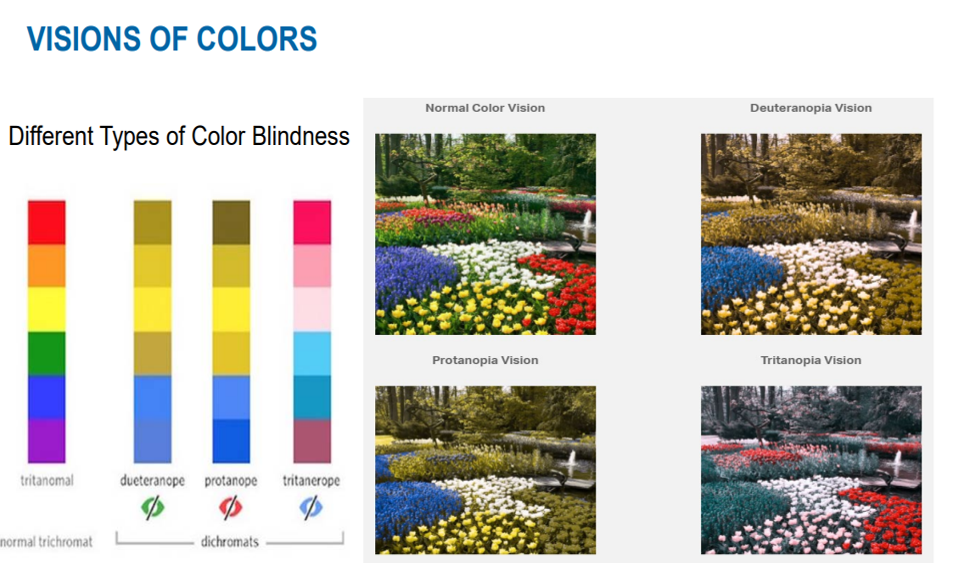
About 300 million people worldwide have color blindness (also known as color vision deficiency). One in 12 men (8%) and 1 in 200 women (0.5%) are color blind, which can have an impact on their education, grades, career choice, and even career growth, as well as how they see and engage with visuals such as charts, photographs, and presentations.
People with color blindness see colors differently than most and have trouble distinguishing between shades. The most common type of color blindness affects the perception of red and green, according to the National Eye Institute. Blue-yellow color blindness is less common, while complete color blindness is quite uncommon.
The primary cause of color blindness is a lack of light-sensitive pigments in the cones of the eye. Color blindness is genetically passed on through the X chromosome. However, diseases such as diabetes can affect color vision, as can aging.
Although genetically caused color blindness cannot be cured, visual aids and other strategies can help. In addition, some people may benefit from special contact lenses or glasses.
As we mark the 32nd anniversary of the Americans with Disabilities Act (ADA) on July 26, 2022, we’re taking a closer look at color blindness and encouraging employers to drive awareness among their employees.
Color Blindness: Experience It
Want to experience what the world is like for someone who is color blind? The example below includes three types of color blindness:
- Deuteranopia and Protanopia, which make green and red look alike.
- Tritanopia, which makes colors look less bright and makes it impossible to distinguish between blue and green, purple and red, and yellow and pink.

Living with Color Vision Deficiency
People with color blindness encounter various difficulties in everyday life, from not being able to judge if a banana is ripe to not realizing they are getting sunburned to being unable to tell if their clothes match.
At home or at work, technology can present issues. For example, LED indicators that change colors can be frustrating for people with color blindness: Is the laptop indicator light flashing red for a low battery or yellow for standby mode?
Potential safety issues associated with color blindness can restrict career choices. An electrician may have difficulty matching color-coded wires; drivers may have trouble identifying the colors of traffic lights.
When organizations are creating customer experiences, they should consider people with color blindness. Making the right color choices ensure that marketing and brand information is accessible and easily understood by all.
How Cigna Is Working to Raise Awareness and Improve Accessibility
At Cigna, our ABLE enterprise resource group (ERG) is working to raise awareness around color blindness. People from across the organization are collaborating within an ADA accommodations work stream to ensure the company is creating accessible experiences for people who are color blind. The workstream members are partnering with Cigna's Creative, Digital Accessibility, Branding, Marketing, Communications, Health Equity, and other business teams to ensure we are creating experiences and communicating in a way that is accessible to everyone.
The team is promoting awareness among Cigna employees with a color blindness intranet resource page. The page features an interactive test (giving perspective into what someone who is color blind may see) and provides an internal color blindness tool kit for employees that includes information on creating color blind-friendly documents.
The team is also putting together learning and training programming around color blindness from a health equity standpoint, working on ways to include color blindness in the content review process, and creating programming that focuses on color blind-friendly themes and colors.
The Onus is on Employers to Drive Awareness
Other organizations interested in taking similar steps can consider forming a multi-disciplinary workgroup with people who do and do not experience color blindness to address this or other accessibility challenges, both internally and externally, and to identify areas of opportunity. These workgroups can review any presentations, print materials, reporting and graphics to ensure that they do not rely on color or require the ability to distinguish color to understand the content (such as using colors and symbols).
For example:
- While presenting visual content, providing the location, placement or position is helpful to identify the item you are pointing to in ways other than its color, such as calling out that the item is at the top left corner of the screen.
- When using spreadsheets, add border lines in the data areas to make it easier to distinguish between breaks in the cells or sections.
- For charts and graphs, use patterns and avoid problematic color combinations such as green and red, green and yellow, or blue and purple.
- For web pages, ensure that the content is available in other formats, such as captions.
In addition, organizations can create learning materials and implement training for employees and customers, operational groups, engineers, app developers, content creators, and anyone else who creates or shares visual content.
The time is now for employers to raise awareness of the limitations and experiences faced by people with color blindness. Greater awareness and education will create more empathy among colleagues, a better employee experience, and more inclusive and accessible marketing, communications, and customer experiences.

Diversity, Equity, and Inclusion
At Cigna, we are committed to respecting differences, treating each other fairly, and standing together. We take an expansive view of diversity, including race, ethnicity, nationality, gender, veteran status, ability, sexual orientation, and gender identity.